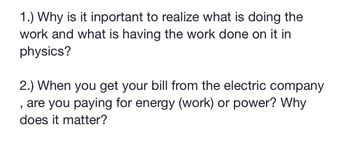Question

Transcribed Image Text:**Questions:**
1.) Why is it important to realize what is doing the work and what is having the work done on it in physics?
2.) When you get your bill from the electric company, are you paying for energy (work) or power? Why does it matter?
---
**Explanation:**
1. **Understanding Work in Physics:**
In physics, the concept of work involves a force causing an object to move in the direction of the force. It is crucial to differentiate between what is doing the work (the source of the force) and what is having the work done on it (the object that is receiving the force). This distinction helps clarify the relationship between forces, energy transfer, and motion, providing insights into how systems behave and interact. For example, in a simple scenario, when you push a box across a floor, your muscles are doing the work, and the box is having the work done on it. Recognizing these roles helps to better understand and analyze various physical situations and principles.
2. **Understanding Energy vs. Power in Electric Bills:**
When you receive your bill from the electric company, you are primarily charged for energy consumption, typically measured in kilowatt-hours (kWh). Energy refers to the total amount of work done or electricity used over a period. Power, on the other hand, measures the rate at which energy is used, generally expressed in watts (W) or kilowatts (kW).
Understanding the difference matters because:
- **Energy** directly correlates to cost: The more energy you use, the higher the bill regardless of the rate at which you consume it.
- **Power** can affect rates: Some utility companies charge different rates depending on your peak power usage.
Hence, comprehending these concepts aids in managing and reducing your electricity expenses through strategies like using energy-efficient appliances and spreading out usage to avoid high peaks in power consumption.
Expert Solution
This question has been solved!
Explore an expertly crafted, step-by-step solution for a thorough understanding of key concepts.
Step by stepSolved in 3 steps with 2 images

Knowledge Booster
Similar questions
- Will rate!! A Freebody diagram is foreign object is shown in the figure. FA = 420 N, FB = 300 N, FC = 275N, and FD = 295N. Assume angle left = 31degrees, and alpha =13 degree. How much work in (J) does FA do on the object if it moves 2.9 m downward?arrow_forwardExplain how you know there is work being done on an object?arrow_forward5) A 2,200 kg car goes flying off a highway overpass in a Hollywood movie. How much potential energy does the car have if the overpass is 25 meters high?arrow_forward
- A kilowatt-hour (kWh) is a unit of measure equal to one thousand watts of electricity being used in one hour. Power companies use this measurement to determine your home energy bill. Consider using a bike for power: It takes 6 minutes pedalling at 24-26 volts consistently to produce just 1/10 (0.1) of a kWh. An average home uses about 25 kWh a day. How long would someone have to pedal at 24-26 Volts to power an average home?arrow_forward2. The same cart and hanging mass given above are released from rest. How far has the cart traveled by the time it reaches a speed of 1.00 m/s?arrow_forwardElectric cars convert approximately 60% of the energy stored in their batteries into vehicle movement. How much energy stored in their batteries is required in order to bring a 2200 kg electric car from rest to a highway speed of 110 km/h? Ignore any effects of air drag.arrow_forward
arrow_back_ios
arrow_forward_ios